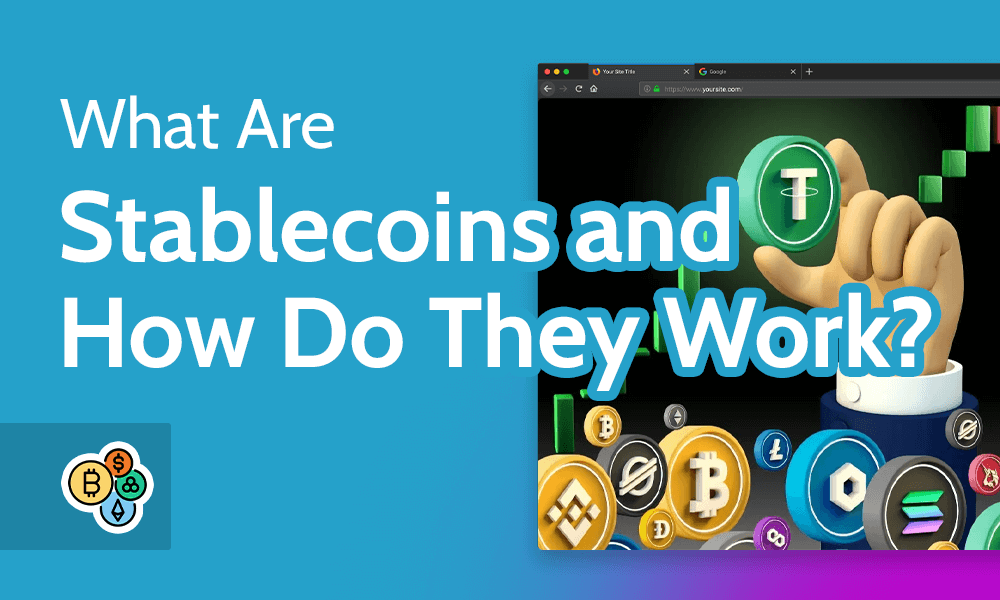
Even as the crypto winter rages all around us, stablecoins are often lauded as the way in which cryptocurrency can be made viable. What are stablecoins, though, and how can they be used to stabilize both crypto and our faith in it?
Key Takeaways: Stablecoins
- Stablecoins are a specific type of crypto token that has its value tied to another asset, thus making it less volatile than other tokens.
- Some stablecoins are tied to existing currencies, while others may be pegged to commodities like gold or even other crypto assets.
- Stablecoins are mostly used to facilitate the buying and selling of other crypto coins.
- Though stablecoins may appear stable, there is still a lot that may destabilize them, especially since there’s little regulation in the space.
Stablecoins take many forms, from those linked to fiat currency to others that have advanced math determine their value. There are even governments moving to underwrite their value, and rating agency Moody’s may even start scoring them like any other currency. Let’s go over how all this works and the risks associated with stablecoins.
-
Stablecoins are digital tokens that are either backed by tangible assets or math, and are used mainly in the marketplace to buy and sell other crypto.
-
Stablecoins are as subject to the vagaries of crypto as any other crypto asset, though their value is a little more grounded in the real world.
-
Depegging is when a stablecoin loses parity with the asset or currency it’s pegged to, so it’s no longer worth what its issuer claims.
-
Stablecoins are a lot more… well, stable… than regular cryptocurrency, but that doesn’t necessarily make them a safe investment. As with all things crypto, caution is advised.
Stablecoins are digital tokens that are either backed by tangible assets or math, and are used mainly in the marketplace to buy and sell other crypto.n”}},{“@type”:”Question”,”name”:”Are Stablecoins Safe?”,”acceptedAnswer”:{“@type”:”Answer”,”text”:”
Stablecoins are as subject to the vagaries of crypto as any other crypto asset, though their value is a little more grounded in the real world.n”}},{“@type”:”Question”,”name”:”What Does u201cDepeggingu201d Mean in Crypto?”,”acceptedAnswer”:{“@type”:”Answer”,”text”:”
Depegging is when a stablecoin loses parity with the asset or currency itu2019s pegged to, so itu2019s no longer worth what its issuer claims.n”}},{“@type”:”Question”,”name”:”Are Stablecoins a Good Investment?”,”acceptedAnswer”:{“@type”:”Answer”,”text”:”
Stablecoins are a lot moreu2026 well, stableu2026 than regular cryptocurrency, but that doesnu2019t necessarily make them a safe investment. As with all things crypto, caution is advised.n”}}]}]]>
What Are Stablecoins: Pegged Cryptocurrency Explained
In short, stablecoins are a form of cryptocurrency that are supposedly less volatile than other crypto assets. Unlike Bitcoin, say, their value isn’t determined by what people are willing to pay for them, but by the value of another currency, commodity or something less tangible — but more on that later.
How Do Stablecoins Work?
This tying of a stablecoin’s value to an external or underlying asset is called “pegging.” When a stablecoin is pegged to an asset, its price rises and falls with the price of that asset.
For example, well-known stablecoin USD Coin is pegged to the U.S. dollar and aims to have parity with it — meaning that one buck will buy you one USD Coin. It’s even in its ticker symbol, the letters that denote a cryptocurrency: USDC.
For example, when you buy some of the currency via an exchange.
Besides being pegged, stablecoins are a little different in other ways, too. For one, most of them aren’t mined, but minted, meaning somebody controls the supply. Stablecoin issuers aren’t inherently more trustworthy than any other crypto issuer. The only difference is that the value of stablecoins is based on something more than the whims of the market.
What Are Stablecoins Used For?
Because they’re less volatile than most cryptocurrencies, stablecoins have become something of a bridge between real-world money and digital currency. Instead of buying Bitcoin or Ether or what have you directly with U.S. dollars, British pounds or another fiat currency, you’ll first buy a stablecoin from your exchange and then use that to buy your crypto of choice.
As such, stablecoins are supposed to add some stability to the wildly oscillating crypto ecosystem. Unlike more volatile cryptocurrencies, the ones that make millionaires and headlines, stablecoins are the more staid, sensible coins that keep order in an anarchic Web3 — or are they?
What Keeps Stablecoins Stable?
The mechanisms that prevent stablecoins from experiencing the wild swing of the rest of the crypto market are surprisingly complicated. However, there are basically two types of stablecoin: those that are backed by something tangible, and those that are not.
Collateralized Stablecoins
The first type is the easiest to grasp: these are coins that are pegged to another asset. The simplest examples are what are called fiat-collateralized stablecoins. In this case, “collateral” means that there’s something to fall back on. A good example is a mortgage, where the collateral is the house you’re buying and any other assets you may have.
In the case of stablecoins, it means that for every coin out there, there’s an equivalent U.S. dollar, British pound or euro with the stablecoin issuer. For example, Tether — the issuer of Tether (USDT) — holds U.S. Treasury bills that are directly worth their face value in “real” U.S. dollars to underpin its stablecoin.
Because Tether keeps these “real” dollars in reserve, you can know that one USDT is indeed worth $1. This is also why the U.S. dollar is called Tether’s “reserve currency.”
Theoretically, for every 100 Tether, the company holds one of these.
Of course, there’s no rule that says stablecoins need to be pegged to fiat currencies. Plenty of others have precious metals as their underlying asset. PAX Gold (PAXG) unsurprisingly uses gold, and you can probably guess what one SilverCoin is backed by.
A third type of collateralized stablecoin doesn’t use real-world assets like gold or dollars, but instead relies on other crypto as its reserve asset. How this works is pretty complex, but essentially what happens is that the issuer has more in reserve than the stablecoin is worth.
A good example is Maker Dai (DAI), which has issued $1 million worth of tokens, but holds $2 million worth of Ether (ETH) in reserve.
Algorithmic Stablecoins
Though in practice it gets complicated, the basic idea of collateralized stablecoins is simple: $1 in digital money is backed by the same amount of real money, precious metals or double the value of another crypto. However, there’s a second type — namely, non-collateralized or algorithmic stablecoins.
An algorithmic stablecoin is backed by nothing but math. It maintains its peg by calculating how much of the currency needs to be in circulation — often determined by the complex interplay of market capitalization (how much the total supply of a coin is worth), the existing supply and projected future demand — and producing more or less as the case may be.
It’s an extremely complex system that requires an advanced degree in anything math-related to properly understand. Even this fairly basic primer by Decrypt quickly runs into some tricky terminology and complicated concepts. The upshot of this type of stablecoins is that their peg is based on numbers, not reserve assets.
Stablecoin Risks
Of course, all the above looks great on paper, but how do stablecoins fare in the real world? Well, the results are mixed at best. Several popular stablecoins weren’t true to their name and have wobbled a fair bit in price, with some throwing a full-on conniption fit and depegging entirely.
Risk of Depegging
Depegging is simply when a stablecoin loses its parity with a fiat currency or another underlying collateral. Generally speaking, there’s some give in the relation — it’s not like a crypto losing a penny to the dollar will send a financial institution into a tizzy and cause the system to come crashing down, but a 10% loss of parity is a serious matter.
So far, the stablecoins most vulnerable to depegging have been algorithmic stablecoins; unsurprisingly, having a currency rely entirely on math and the bluff isn’t the best prescription for financial health.
The most well-known example is probably the TerraUSD collapse, where a stablecoin suddenly lost parity, collapsing its related cryptocurrency called LUNA. There was a real chance this single loss of a peg could cause all crypto to come crashing down until FTX stepped in and bailed LUNA out. Check out our article on the FTX scandal to find out what happened after that.
Lack of Regulation
However, it’s not just the math that makes stablecoins risky: Crypto-collateralized stablecoins and stablecoins backed by fiat currency may not always be safe: since there’s little regulation in the space, an issuer may not always have all the currency it promises. For example, there was a brief panic in 2021 when Tether was rumored not to have the reserves it said it had.
Though Tether is one of the more reliable players in the stablecoin market, it hasn’t been immune to a few moments of panic.
This lack of regulation leads to another issue, one common to every other type of crypto asset: namely, whether you can trust a stablecoin issuer. Often, we rely on their word to know how much of a digital currency is out in the market; it could very well be more than they claim, which would devalue the coin.
Scams abound in the crypto space (check out our overview of NFT scams), and there’s no rule that says stablecoins are any different. It’s not like the smart contracts that govern these types of deals can always be relied on, and it often seems that law enforcement spends more time wrangling over who has jurisdiction in the case rather than going after the scammers.
Then again, if regulation were to come into the world of stablecoins to fix some of these issues, it’s questionable how welcome it would be. Many investors in the space seem to like that there are no laws to speak of, and take the heightened risk as a way to add some spice to their investing.
Final Thoughts: Fiat Currency vs Stablecoin
As much as their issuers would like you to believe that stablecoins are the future of money, the fact is that it’s all still up in the air, just like everything else crypto-related. It could be that in a few years, the crypto skeptics will be revealed as doubting Thomases who let a good opportunity pass them by.
Then again, there’s very little to inspire confidence in crypto in general, and stablecoins in particular. Though it may seem on paper like they’re a good bet, the story of Terra shows that math isn’t enough to base a currency on and even things like gold-backed stablecoins have had their ups and down.
That said, even regulated financial institutions are expressing interest in minting their own stablecoin, with the British government going so far as to make actual plans to do so. Whether these types of central bank digital currencies (CBDC) will prove to be the future remains to be seen, especially since many current investors don’t seem to relish the opportunity.
What do you think? Are stablecoins the future of finance, or are they another crypto pie in the sky? Would you buy and hold on to a few of these coins? Or would you rather just hang on to your cash? Let us know in the comments below and, as always, thank you for reading.
Let us know if you liked the post. That’s the only way we can improve.


